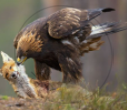Advertisements
Advertisements
प्रश्न
Name important defence mechanisms in plants against herbivory.
उत्तर
For plants, herbivores are the predators. Nearly 25 per cent of all insects are known to be phytophagous (feeding on plant sap and other parts of plants). The problem is severe for plants because, unlike animals, they cannot run away from their predators. Plants, therefore, have evolved an astonishing variety of morphological and chemical defences against herbivores. Thorns and spines (Acacia, cactus) are the most common morphological means of defence. Some plants release toxins that poison attacking herbivores, while others produce complex compounds that affect the attacker's growth cycle or ability to digest the plant. Plants have evolved several secondary metabolites used in plant defence, known as antiherbivory chemicals. These are nitrogen compounds (alkaloids, cyanogenic glycosides, benzoxazinoids), terpenoids, and phenolics. The weed Calotropis grows in abandoned fields. This plant produces highly poisonous cardiac glycosides. This is the reason why any cattle or goats are not commonly seen grazing on this plant.
APPEARS IN
संबंधित प्रश्न
State Gause’s Competitive Exclusion Principle.
Define the Stenothermal organisms
What is population ecology?
What is Commensalism? Explain it with suitable example.
Explain parasitism.
Which principle/theory states that 'Two closely related species competing for the same resources cannot co-exist indefinitely and the competitively inferior will be eliminated eventually.'?
Mutualism can be represented as the interaction between ____________.
Identify the interspecific interaction depicted in the following figure.

Which of the following is TRUE for amensalism?
Which of the following is NOT an example of mutualism?
A protozoan living in the digestive tract of a flea that lives on a dog is an example of ______
What is brood parasitism? Explain with the help of an example.
Give one example for the following type.
Camouflaged animal
Pick out the appropriate association representing brood parasitism.
Match the Column I with Column II.
| Column I | Column II |
| A. Lichen | (i) Commensalism |
| B. Shark and Pilot fish | (ii) Mutualism |
| C. Barnacles on the back of a whale | (iii) Symbiotic obligatory relationship |
| D. Sharks and dolphins | (iv) Competition |
"Abingdon tortoise in Galapagos islands became extinct within a decade on introduction of goats in the island." Explain giving reason.
Many copepods live on the body surface of marine fish. This relationship is an example of ______.
What happens to an inferior competitor if a superior competitor is present in the same environment?
What happens to an inferior competitor if the superior competitor is removed from the environment?
Give one example of Camouflage.
